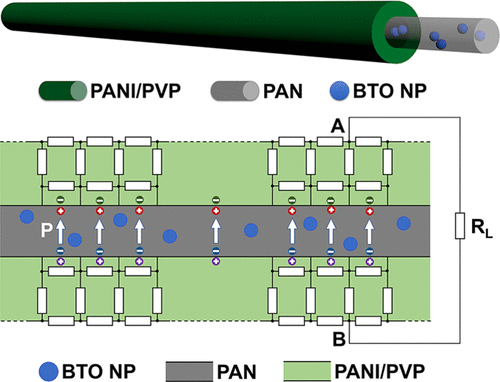当前位置:
X-MOL 学术
›
ACS Appl. Electron. Mater.
›
论文详情
Our official English website, www.x-mol.net, welcomes your feedback! (Note: you will need to create a separate account there.)
Synchronous Construction of Piezoelectric Elements and Nanoresistance Networks for Pressure Sensing Based on the Wheatstone Bridge Principle
ACS Applied Electronic Materials ( IF 4.7 ) Pub Date : 2021-09-01 , DOI: 10.1021/acsaelm.1c00509 Nan Lv 1 , Wenbo Jiang 1 , Kongsen Hu 1 , Zhiwei Lyu 2
ACS Applied Electronic Materials ( IF 4.7 ) Pub Date : 2021-09-01 , DOI: 10.1021/acsaelm.1c00509 Nan Lv 1 , Wenbo Jiang 1 , Kongsen Hu 1 , Zhiwei Lyu 2
Affiliation

|
Fabrication of flexible piezoelectric sensing nanomaterials is essential for the development of wearable and microscopic electronic devices. However, existing piezoelectric sensing materials usually rely on the secondary synthesis process to accomplish the preparation of conductive layer electrodes. Here, we report a one-step strategy for synchronous construction of piezoelectric elements and nanoresistance networks via fabricating flexible [polyacrylonitrile/BaTiO3]@[polyaniline/polyvinyl pyrrolidone] core–shell nanofibers (NFs, denoted [PAN/BTO]@[PANI/PVP]) by coaxial electrospinning. This is the first time to collect and output voltage signals generated by piezoelectric materials through nanoresistance networks based on the Wheatstone bridge principle. As a result, flexible [PAN/BTO]@[PANI/PVP] core–shell NFs as an integrated sensing system without layer electrodes can directly result in voltage signals under repeating press–release motions. The potential of a flexible core–shell [PAN/BTO]@[PANI/PVP] integrated nanofiber membrane (INFM) for pressure sensing is properly explored and evaluated. The integration of piezoelectric elements and nanoresistance networks enables the INFM to perceive pressures with high sensitivity (728 mV N–1) down to approximately 0.05 N and a quick response (26 ms). Overall, our study demonstrates a promising strategy to fabricate nanoscale, highly sensitive, and low-cost integrated sensing materials, which have potential applications in micro-/nanoscale sensors and wearable electronics.
中文翻译:

基于惠斯通电桥原理的压力传感压电元件和纳米电阻网络的同步构建
柔性压电传感纳米材料的制造对于可穿戴和微型电子设备的开发至关重要。然而,现有的压电传感材料通常依靠二次合成过程来完成导电层电极的制备。在这里,我们报告了一种通过制造柔性 [聚丙烯腈/BaTiO 3 ]同步构建压电元件和纳米电阻网络的一步策略]@[聚苯胺/聚乙烯吡咯烷酮]核壳纳米纤维(NFs,表示为[PAN/BTO]@[PANI/PVP])通过同轴静电纺丝。这是首次通过基于惠斯通电桥原理的纳米电阻网络采集和输出压电材料产生的电压信号。因此,灵活的 [PAN/BTO]@[PANI/PVP] 核壳 NF 作为没有层电极的集成传感系统可以在重复的新闻发布运动下直接产生电压信号。正确探索和评估了用于压力传感的柔性核壳 [PAN/BTO]@[PANI/PVP] 集成纳米纤维膜 (INFM) 的潜力。压电元件和纳米电阻网络的集成使 INFM 能够以高灵敏度(728 mV N –1) 下降到大约 0.05 N 和快速响应 (26 ms)。总体而言,我们的研究展示了一种制造纳米级、高灵敏度和低成本集成传感材料的有前景的策略,这些材料在微/纳米级传感器和可穿戴电子产品中具有潜在应用。
更新日期:2021-09-28
中文翻译:

基于惠斯通电桥原理的压力传感压电元件和纳米电阻网络的同步构建
柔性压电传感纳米材料的制造对于可穿戴和微型电子设备的开发至关重要。然而,现有的压电传感材料通常依靠二次合成过程来完成导电层电极的制备。在这里,我们报告了一种通过制造柔性 [聚丙烯腈/BaTiO 3 ]同步构建压电元件和纳米电阻网络的一步策略]@[聚苯胺/聚乙烯吡咯烷酮]核壳纳米纤维(NFs,表示为[PAN/BTO]@[PANI/PVP])通过同轴静电纺丝。这是首次通过基于惠斯通电桥原理的纳米电阻网络采集和输出压电材料产生的电压信号。因此,灵活的 [PAN/BTO]@[PANI/PVP] 核壳 NF 作为没有层电极的集成传感系统可以在重复的新闻发布运动下直接产生电压信号。正确探索和评估了用于压力传感的柔性核壳 [PAN/BTO]@[PANI/PVP] 集成纳米纤维膜 (INFM) 的潜力。压电元件和纳米电阻网络的集成使 INFM 能够以高灵敏度(728 mV N –1) 下降到大约 0.05 N 和快速响应 (26 ms)。总体而言,我们的研究展示了一种制造纳米级、高灵敏度和低成本集成传感材料的有前景的策略,这些材料在微/纳米级传感器和可穿戴电子产品中具有潜在应用。


























 京公网安备 11010802027423号
京公网安备 11010802027423号